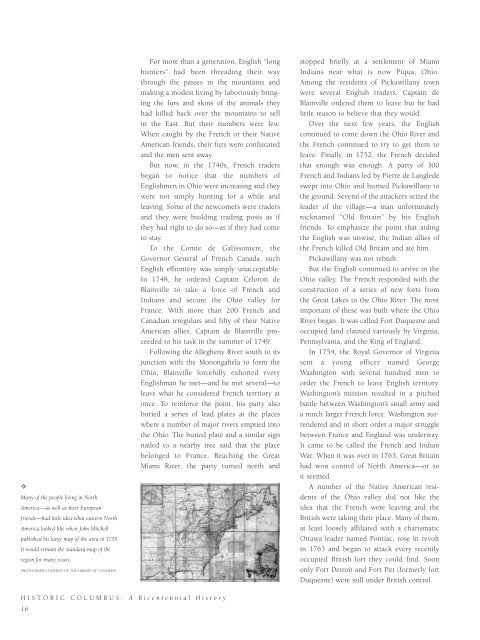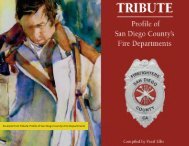Historic Columbus
An illustrated history of the City of Columbus, Ohio, paired with the histories of companies, families and organizations that make the region great.
An illustrated history of the City of Columbus, Ohio, paired with the histories of companies, families and organizations that make the region great.
Create successful ePaper yourself
Turn your PDF publications into a flip-book with our unique Google optimized e-Paper software.
✧<br />
Many of the people living in North<br />
America—as well as their European<br />
friends—had little idea what eastern North<br />
America looked like when John Mitchell<br />
published his large map of the area in 1755.<br />
It would remain the standard map of the<br />
region for many years.<br />
PHOTOGRAPH COURTESY OF THE LIBRARY OF CONGRESS.<br />
For more than a generation, English “long<br />
hunters” had been threading their way<br />
through the passes in the mountains and<br />
making a modest living by laboriously bringing<br />
the furs and skins of the animals they<br />
had killed back over the mountains to sell<br />
in the East. But their numbers were few.<br />
When caught by the French or their Native<br />
American friends, their furs were confiscated<br />
and the men sent away.<br />
But now, in the 1740s, French traders<br />
began to notice that the numbers of<br />
Englishmen in Ohio were increasing and they<br />
were not simply hunting for a while and<br />
leaving. Some of the newcomers were traders<br />
and they were building trading posts as if<br />
they had right to do so—as if they had come<br />
to stay.<br />
To the Comte de Galissoniere, the<br />
Governor General of French Canada, such<br />
English effrontery was simply unacceptable.<br />
In 1748, he ordered Captain Celoron de<br />
Blainville to take a force of French and<br />
Indians and secure the Ohio valley for<br />
France. With more than 200 French and<br />
Canadian irregulars and fifty of their Native<br />
American allies, Captain de Blainville proceeded<br />
to his task in the summer of 1749.<br />
Following the Allegheny River south to its<br />
junction with the Monongahela to form the<br />
Ohio, Blainville forcefully exhorted every<br />
Englishman he met—and he met several—to<br />
leave what he considered French territory at<br />
once. To reinforce the point, his party also<br />
buried a series of lead plates at the places<br />
where a number of major rivers emptied into<br />
the Ohio. The buried plate and a similar sign<br />
nailed to a nearby tree said that the place<br />
belonged to France. Reaching the Great<br />
Miami River, the party turned north and<br />
stopped briefly at a settlement of Miami<br />
Indians near what is now Piqua, Ohio.<br />
Among the residents of Pickawillany town<br />
were several English traders. Captain de<br />
Blainville ordered them to leave but he had<br />
little reason to believe that they would.<br />
Over the next few years, the English<br />
continued to come down the Ohio River and<br />
the French continued to try to get them to<br />
leave. Finally, in 1752, the French decided<br />
that enough was enough. A party of 300<br />
French and Indians led by Pierre de Langlede<br />
swept into Ohio and burned Pickawillany to<br />
the ground. Several of the attackers seized the<br />
leader of the village—a man unfortunately<br />
nicknamed “Old Britain” by his English<br />
friends. To emphasize the point that aiding<br />
the English was unwise, the Indian allies of<br />
the French killed Old Britain and ate him.<br />
Pickawillany was not rebuilt.<br />
But the English continued to arrive in the<br />
Ohio valley. The French responded with the<br />
construction of a series of new forts from<br />
the Great Lakes to the Ohio River. The most<br />
important of these was built where the Ohio<br />
River began. It was called Fort Duquesne and<br />
occupied land claimed variously by Virginia,<br />
Pennsylvania, and the King of England.<br />
In 1754, the Royal Governor of Virginia<br />
sent a young officer named George<br />
Washington with several hundred men to<br />
order the French to leave English territory.<br />
Washington’s mission resulted in a pitched<br />
battle between Washington’s small army and<br />
a much larger French force. Washington surrendered<br />
and in short order a major struggle<br />
between France and England was underway.<br />
It came to be called the French and Indian<br />
War. When it was over in 1763, Great Britain<br />
had won control of North America—or so<br />
it seemed.<br />
A number of the Native American residents<br />
of the Ohio valley did not like the<br />
idea that the French were leaving and the<br />
British were taking their place. Many of them,<br />
at least loosely affiliated with a charismatic<br />
Ottawa leader named Pontiac, rose in revolt<br />
in 1763 and began to attack every recently<br />
occupied British fort they could find. Soon<br />
only Fort Detroit and Fort Pitt (formerly fort<br />
Duquesne) were still under British control.<br />
H I S T O R I C C O L U M B U S : A B i c e n t e n n i a l H i s t o r y<br />
16
















